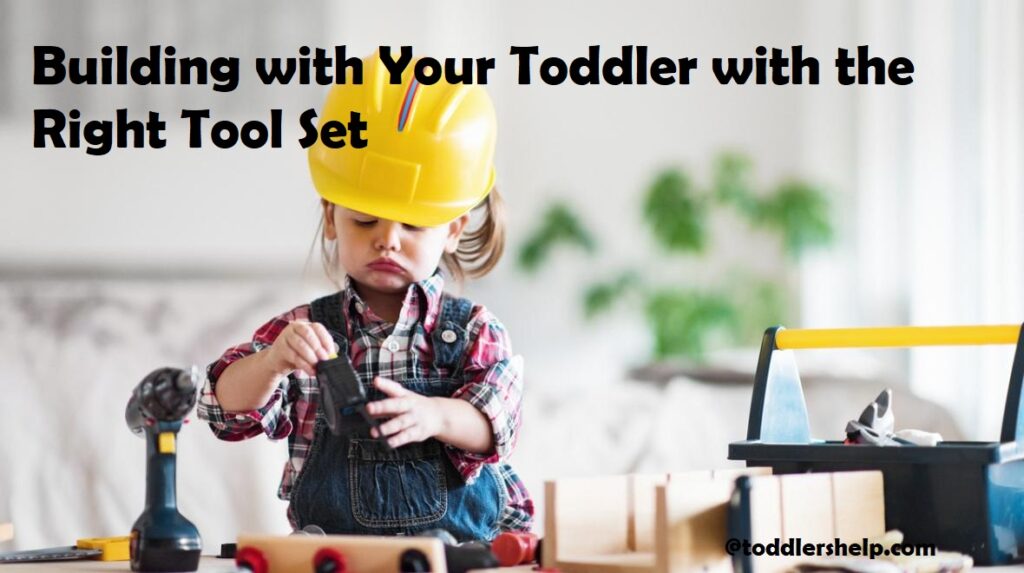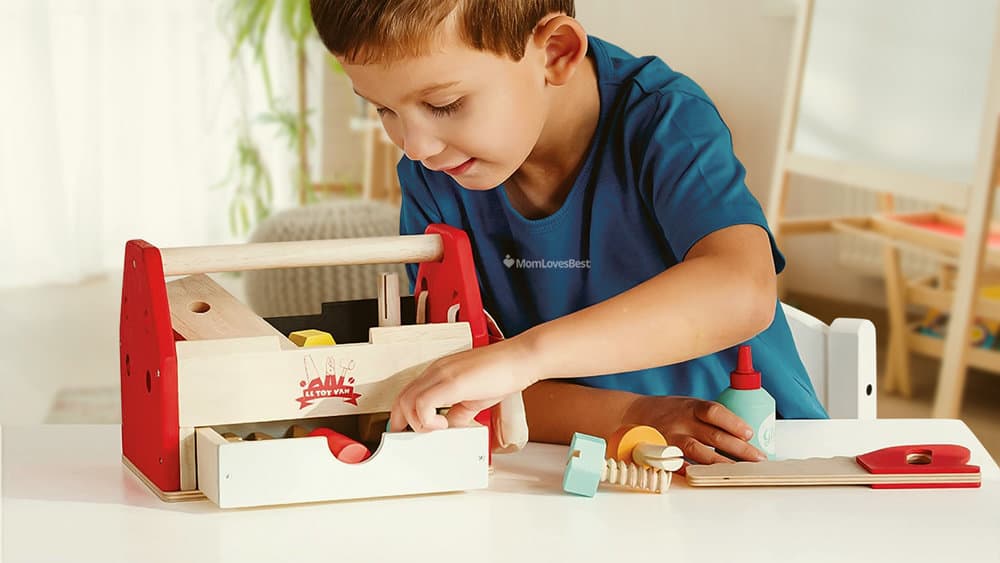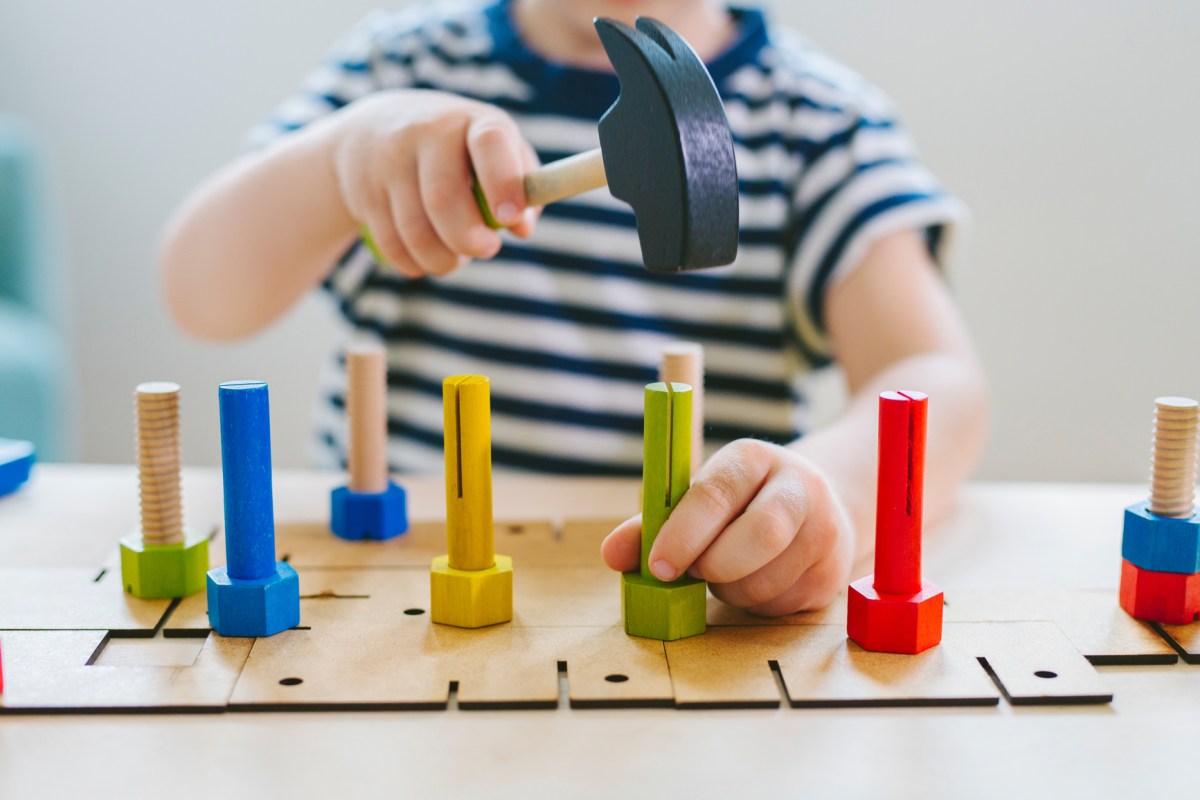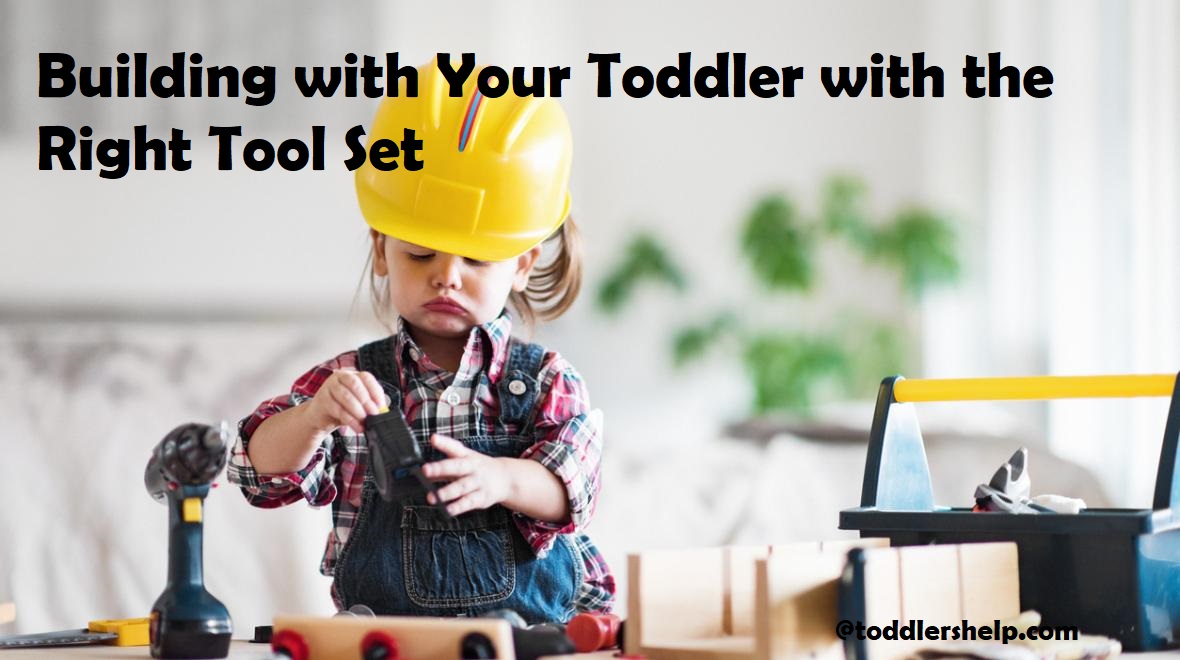Are you looking for creative ways to get your toddler excited about building? Then look no further- this complete guide will provide you with the perfect tool set to have fun and learn together.
From constructing blocks to drawing with chalks, it’s time to create lasting memories while cultivating your toddler’s creativity!
Welcome to the complete guide for building with your toddler with the right tool set! With this guide, you’ll learn the basics of choosing and using tools in order to make building projects with your toddler safe, educational, and fun.
We’ll give you an introduction to different types of tools that can be used in construction, and explain the safety guidelines that must be respected when using them. In addition, we will provide a range of building project ideas for toddlers that are appropriate for their age and developmental level.
Whether your toddler is just learning to use basic hand tools or has already gained mastery over more advanced power tools, they can build while having a blast! So let’s get started learning the essentials of tool safety and developmentally-appropriate projects that you can do together.
Explanation of the importance of building with toddlers
Engaging in building activities with toddlers can be incredibly beneficial for their development. What may seem like simple playtime to adults, is actually providing children with the opportunity for hands-on problem solving in a safe and constructive manner. Building activities help to foster important life skills that include resolving conflicts, dealing with frustration and recognizing cause and effect. These kinds of experiences contribute enormously to their overall comprehension of the world.
Building activities also stimulate creative thinking skills and encourage an understanding of basic math concepts such as counting, spatial awareness, geometric shapes, sorting and yes – even adding and subtracting! The more exposure children have to problem solving scenarios, the greater their confidence in tackling challenges becomes. The use of appropriate tools also allows them to gain a sense of control over their own lives which can be essential when establishing feelings of self-confidence in young children.
Brief overview of the benefits of using the right tool set
Using the right tool set when you build with your toddler boosts their learning experience immensely and helps create a sense of accomplishment. For example, the construction pieces are larger and easier to put together than smaller models, which means that your child can perform tasks without getting frustrated. Small problems like placing a screw in the exact place or tightening a joint correctly become easier for them as they gain confidence.
With well-designed tools that are crafted for small hands to manage, your toddlers will be able to accomplish their building goals with ease. Additionally, by having the appropriate tools at hand, you are teaching your children important lessons about using tools safely and efficiently. It also allows them to acquire motor skills such as twisting screws or hammering nails without fear of injury or frustration. Likewise, enhanced problem-solving abilities can be attained more quickly when they practice with age-appropriate building sets.
As parents we want our children to obtain an enjoyable and rewarding experience while exploring their creativity as they develop new concepts in construction projects. A functional and safe tool set is an essential part of this process that should not be overlooked!
Choosing the Right Tool Set
It is important to consider age-appropriate tool sets when introducing your toddler to the world of building. This is vital to ensure that your child is safe while exploring and engaging in creative activities. The best way to determine safe, appropriate tools for your child’s age is to consult with a professional or read reviews from parents who have tried a specific product.
Some safety tips for selecting tools for children include:
- Look for tools with wide, rounded handles and as few moving parts as possible.
- Avoid tools with pointy or sharp edges that could cause harm.
- Ensure all pieces are non-toxic and safely constructed without sharp seams or rough edges that could leave marks on furnishings, floors, ceilings and walls.
- Opt for products made from wood instead of plastic whenever possible since wood does not scratch as easily as plastic does and can often be more durable over time.
- Be sure the tool set comes with clear instructions so you understand which pieces are intended for use with each individual project before beginning assembly.
- Read customer feedback from other parents to get an unbiased opinion on how well the set works under normal conditions before purchasing it.
Factors to consider when selecting a tool set for toddlers
Selecting the right tool set for your toddler can long-lasting impact on their playing experience. To make the selection process easier, consider the following factors:
Safety – Tool sets designed specifically for toddlers include safety features like blunt edges, adjustable trigger forces and plastic materials that are gentle enough for young hands. Many also come with a designated storage case to reduce toddler’s risk of injury when not in use.
Variety– Look for tool sets that come with a variety of tools and accessories. This helps develop a variety of skills, such as fine motor, hand-eye coordination, creative thinking and problem solving abilities.
Durability– Tools made of heavy duty plastic or aluminum are ideal as they last longer than lightweight options. While children should not be using power tools, look out for more advanced options with battery packs, dials and electronic controls – this will help them grow with confidence in their building craftsmanship.
Age Appropriate– Toys should always be age appropriate in order to ensure safety and to challenge behaviors and cognitive development appropriately for each stages of development. Generally speaking olders toddlers require more complex tools compared to younger ones who will need simpler projects that still provide entertainment value but are easy enough to handle.
Learning Opportunities – When selecting the perfect kit, it is important to note what learning opportunities you want your toddler to gain from the experience – from basic construction techniques like joining two pieces together or attaching nuts and bolts all the way through to understanding why something is constructed a certain way or using specific materials. Educative instruction manuals can really help bring many of these concepts home and it is great when incorporated into toy building sets too!
Recommended tool sets for toddlers
Buying the right tool set for your toddler can be a daunting task, but it’s an important one. Quality tools are not only safer than plastic or cheap alternatives, but they can also help your little one develop their skills and confidence when it comes to building. Here is a guide to help you choose the perfect tool set for your adventurous tot!
First, consider the age range of your toddler. Typically, children between 18 months and 3 years of age should start with an introductory tool set that features hand size pieces to encourage coordination and fine motor skills. It’s best to choose a colorful set of six basic pieces: hammer, saw, screwdriver, wrench, pliers, and clamps. The handles should be easy to grip and lightweight so they won’t tire out little hands too quickly while they’re building.
As your child grows older (ages 4-5), it’s time to upgrade to a more comprehensive set with around eight pieces. Medium-sized tools with longer handles will provide improved leverage so small builders can really get into the details when putting together projects like wooden block towers or birdhouses. Look for sets featuring a drill or drill bit (plus battery power) as well as additional basics like ruler and cushion clamping pliers — construction options made just for tiny hands!
Finally once kids reach around 6 years old, larger sets suitable for bigger builds become available in stores or online shops . They should include all of the essential woodworking tools such as heavier-duty hammers plus more specialized items such as sandpaper strips for sanding edges smooth after cuts are made. These sets are quite advanced so we recommend investing in quality pieces from reputable brands like Bosch – if you have any doubts about whether something is safe or appropriate always check the recommended age ratings on the packaging first before buying!
III. Safety Precautions
Whenever young children are involved in building projects, safety should be top of mind. Whether your child will be using simple wooden blocks, LEGOS®, plastic connectors, or saws and hammers with adult supervision, the following safety tips will help ensure your child’s building experience is fun and educational while also being safe:
- Always wear protective eyewear. Most small building projects don’t require anything more than glasses, but always err on the side of caution. Safety goggles are recommended when working with more complicated projects, small parts or tools with moving pieces.
- Wear age-appropriate clothing. Long pants and loose clothing are best to avoid any potential entanglement issues when using power tools. Keep long hair tied back or away from tools or hot surfaces for safety reasons as well.
- Read all instruction manuals beforehand and follow the manufacturer’s guidelines carefully; improper use can lead to injury or even death in extreme circumstances. If you have any questions, clarify before allowing your child to use any tool that may come with materials or kits purchased for them. This applies especially to power tools – research specific models ahead of time if you intend to buy one for your budding builder.
- Store tools away from reach when not in use (especially instruments like saws). Make sure that all pieces are kept out of areas prone to water spills – especially items that include electrical components. A toolkit specifically meant for kids is a great way to store everything together safely away from other areas of the home so there’s no need worry about kids finding access to unsafe areas. Also, make sure all sharp edges are smoothly sanded down before handing over the project materials.
Guidelines for ensuring the safety of toddlers during building activities
When considering activities that are suitable for your toddler, building projects can be a great way to introduce them to problem solving skills, spatial reasoning and hand-eye coordination. Building projects tend to keep their attention while they learn to explore different shapes and sizes. However, like any activity involving hazardous materials and tools, there are certain safety guidelines that you should follow when allowing your toddler to participate in these activities.
Here are some tips for ensuring that your little one has a safe and enjoyable building experience:
* Select age-appropriate toys – In general, tools and materials used in building activities should not include small parts or sharp objects such as metal screws, saws or hammers. Instead look for sets that have been specifically designed for toddlers with objects of different sizes and shapes that will help them practice basic fine motor skills such as stacking blocks or screwing bolts without the risk of injury.
* Monitor their progress – Closely monitor your child’s progress while they use the toys associated with the building project. Keep a watchful eye so they do not put small pieces or parts into their mouth which could cause choking hazards. Additionally, make sure that they remain on task and don’t develop unsafe habits or lack of concentration due to boredom or distraction.
* Educate about safe practices – Use this time with your toddler to teach them about proper tool handling techniques and the importance of safety when handling hazardous materials such as glue or paint.Additionally, be sure teach them why it is important not to touch wiring connections or electrical equipment as this could lead to dangerous shocks or even electrocution if handled incorrectly.
Taking the necessary precautions will ensure that your little one’s experience is rewarding from start finish from start!
Importance of adult supervision
It is important to understand that adult supervision is essential when a child is using building tools. Even though a toddler may be excited and eager to use the tools, any large or sharp objects should not be given to a child without an adult’s presence. An adult should explain the safety rules around using tools such as hammering and sawing, and provide assistance in using any tool that requires particular strength or competence in handling. With the support of an adult, a toddler can learn basic tool use and the concept of safe practices with tools, which can be an invaluable learning experience for a young child.
By engaging in supervised projects with children, adults are also able to introduce task-related concepts such as problem solving and working toward objectives, which can help develop skills essential for future success with building activities. Teaching children how to select materials, evaluate progress on projects, use simple measuring instruments like rulers or tape measures and design correct connections for joining pieces are all valuable lessons for them.
Make sure that you inform your toddler about the various types of building tools available to them so they will know what they need when they start working on their own project. It’s also important to explain why these tools are necessary — not just because they make it easier to build things but also because they involve safety precautions when using them!
Building with Toddlers
Building with toddlers is an enjoyable and rewarding experience for both of you. You get to help your toddler gain valuable visual-spatial skills and have lots of fun building together. The best way to ensure success is to provide your toddler with the correct tools for the task. With guidelines, you can ensure that your home will remain safe as you help your toddler become a builder.
When equipping your child, here are a few tips:
- Select age-appropriate tools that are specifically designed for toddlers — sometimes as young as one year old
- Provide sturdy pieces made of high-grade materials and be sure they are properly maintained
- Be mindful of small pieces so young builders don’t swallow them or get pinched or injured
- Introduce only one tool at a time so not to overwhelm the child with too many options
- For toddlers from 2 through 6 years old, provide adult supervision when possible and consider age-appropriate building kits
- Always start small and always praise success!
This guide provides guidelines to selecting the right tool set for you and helping your toddler build safely for many years to come.
Tips for engaging toddlers in building activities
Building activities can help toddlers develop different skills and prepare them for more involved tasks. Engaging them in these activities helps kids understand cause and effect relationships, plan and visualize solutions, as well as develop their coordination and problem-solving abilities. Below are tips to make building projects fun for your toddler:
- Introduce real tools to your toddler. Toddlers need the right tools to be successful in a building project. As they become more familiar with the tools, they can build confidence in completing even more complicated tasks. Utilizing kitchen tools such as tongs, measuring cups and spoons, wooden cooking utensils, spatulas or whiskers can provide additional fun for a toddler who is ready for more advanced tasks that use real tools rather than toys designed specifically for young children.
- Offer simple puzzles to bolster problem-solving skills: Puzzles are great ways to engage toddlers’ visual-motor abilities while allowing them to become familiar with how pieces fit together. Wooden puzzles that may have only two or three pieces are a great way of introducing toddlers to the idea of building by themselves. Such puzzles won’t overwhelm younger children but offer engaging challenges that require focus and concentration as they work out how pieces fit together.
- Make use of LEGOs: LEGOs are among the most popular toys among all age groups but many parents don’t know there is educational value associated with this toy line too! Apart from teaching your toddlers basic counting skills, LEGOs also help toddlers explore 3D shapes while discovering what happens when blocks interact with one another (elevation, support). The varied colors also stimulate young minds by triggering visual memory responses!
- Create Family Collaborations: Family collaborations on a building activity are always great highlights of family bonding time! Setting small goals and working on achievable tasks together promote positive interactions between adults and children while helping take ideas from concept to reality!
Examples of simple building projects for toddlers
Building projects not only keep toddlers entertained, they also help them develop problem solving and motor skills. The key is to use the right tool set and pick a simple project that will help your toddler understand the basics of building.
Here are some examples of projects that are perfect for young builders:
- Picture frame: A picture frame can be created with a few pieces of scrap wood or cardboard cut into rectangles, painted or decorated in your toddler’s favorite colors and glued together. Your toddler can also add glue decorations such as googly eyes or glitter accents.
- Block towers: Toddlers love making towers out of blocks, and you can encourage creativity by including colorful blocks with different shapes (circles, squares and triangles). Show your toddler how to stack the blocks from bottom to top, starting with the biggest block first.
- Cardboard box car: An old cardboard box can easily be turned into an imaginative car complete with wheels, headlights and steering wheel! You’ll need card stock or craft foam for decorations such as headlights, a steering wheel or gear shift, as well as paint or markers to draw windshields and other details. Cut four small holes in each corner so wheels can be added later on for extra fun.
- Animal sculptures: Create different animal sculptures using wood scraps, paint, googly eyes and felt in creative shapes like claws, ears and tails! Glue all the parts together easily using Elmer’s glue so that your little builder has a new friend made from his imagination!
Benefits of building with toddlers
Building with your toddler can be a great way to introduce them to the world of creativity and teamwork. Building with children not only encourages exploration, problem-solving and inspired learning; it also provides many other benefits.
Building encourages spatial reasoning and problem-solving skills that help prepare kids for success in academics, as well as life. Developing physical skills improves hand-eye coordination, builds strength, developing motor-skills for handwriting puzzle solving which can help develop fine motor skills.
In addition to teaching core academic skills and physical development, building with your toddler helps them learn collaboration, cooperation and socialization in an age-appropriate setting. By teaching the importance of working together from a young age, children will understand the value of collaboration from early on with their peers both now and in life beyond school. Working together also helps boost self-esteem and confidence along with learning how to appropriately resolve conflicts.
Further along in a child’s life, all these experiences will provide a background for success by giving them a blueprint on how to function in different situations. Constructing activities are critical in helping kids become independent thinkers and better prepared students – which is why it’s important that they have the right tools so they can construct properly from the start!
Conclusion
To conclude, building with your toddler using the right tool set can be an exceptionally rewarding experience for both you and your child. It allows you to work together and bond while also teaching your child important developmental skills.
Additionally, it helps foster creativity, problem-solving skills, patience and resilience in a safe and enjoyable way. With the recommended tool sets presented here, you can ensure that your child has the appropriate tools to build whatever their heart desires.
FAQ’S
What is the use of tools toddlers?
Toddlers use tools to help them explore, learn and create.
What are the benefits of children using tools?
Children benefit from using tools by improving their fine motor skills, problem-solving abilities, and hand-eye coordination.
What age do children use tools?
Children can start using simple tools as early as 18 months, but should always be supervised by an adult.
What are the benefits of stacking blocks for toddlers?
Stacking blocks can help improve a toddler’s hand-eye coordination, spatial reasoning, and fine motor skills.
How do I teach my toddler tools?
Teach your toddler how to use tools by providing safe and age-appropriate tools, demonstrating proper use, and supervising their use.
What is the main purpose of tools?
The main purpose of tools is to make tasks easier and more efficient.
What is the toddler class tool?
The toddler class tool refers to the types of tools that are appropriate and safe for toddlers to use in a classroom or learning environment.
What skills do toddlers use?
Toddlers use a variety of skills including fine motor skills, gross motor skills, cognitive skills, and social-emotional skills.
What are the best tools to teach kids time?
The best tools to teach kids time are analog clocks, timers, and calendars.
How do toddlers learn things?
Toddlers learn through play, exploration, and by modeling the behavior of the adults around them.
See Also-
- Best toddler gardening set
- Best toddler nap mat
- Best toddler nail polish
- Best travel crib for toddler
- Best travel crib for tall toddler

